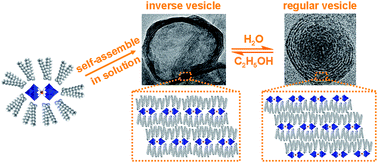Controllable vesicular structure and reversal of a surfactant-encapsulated polyoxometalate complex†
Abstract
An organic–inorganic complex,

* Corresponding authors
a
State Key Laboratory of Supramolecular Structure and Materials, Jilin University, Changchun, China
E-mail:
wulx@jlu.edu.cn
Fax: +86 431 85193421
Tel: +86 431 85168481
An organic–inorganic complex,

 Please wait while we load your content...
Something went wrong. Try again?
Please wait while we load your content...
Something went wrong. Try again?
Y. Yan, B. Li, W. Li, H. Li and L. Wu, Soft Matter, 2009, 5, 4047 DOI: 10.1039/B912011D
To request permission to reproduce material from this article, please go to the Copyright Clearance Center request page.
If you are an author contributing to an RSC publication, you do not need to request permission provided correct acknowledgement is given.
If you are the author of this article, you do not need to request permission to reproduce figures and diagrams provided correct acknowledgement is given. If you want to reproduce the whole article in a third-party publication (excluding your thesis/dissertation for which permission is not required) please go to the Copyright Clearance Center request page.
Read more about how to correctly acknowledge RSC content.
 Fetching data from CrossRef.
Fetching data from CrossRef.
This may take some time to load.
Loading related content
